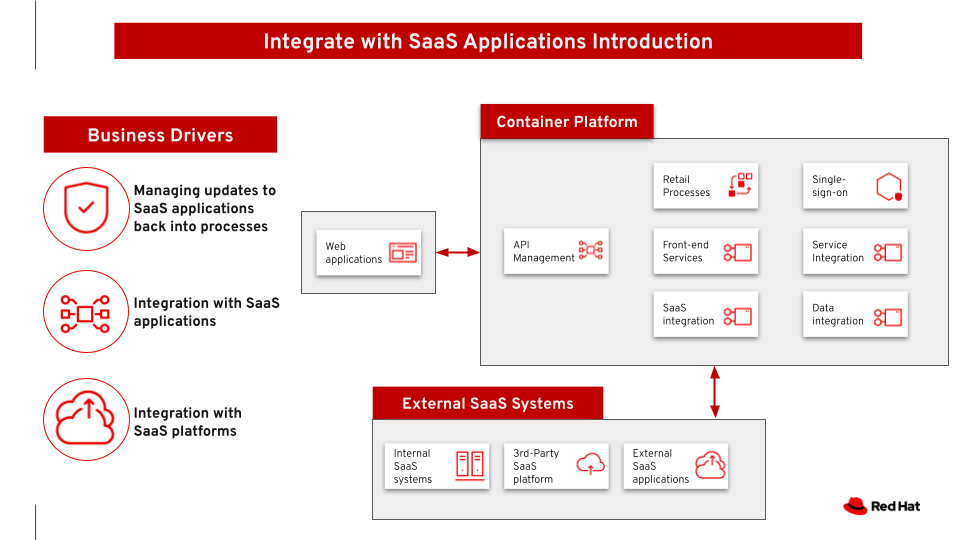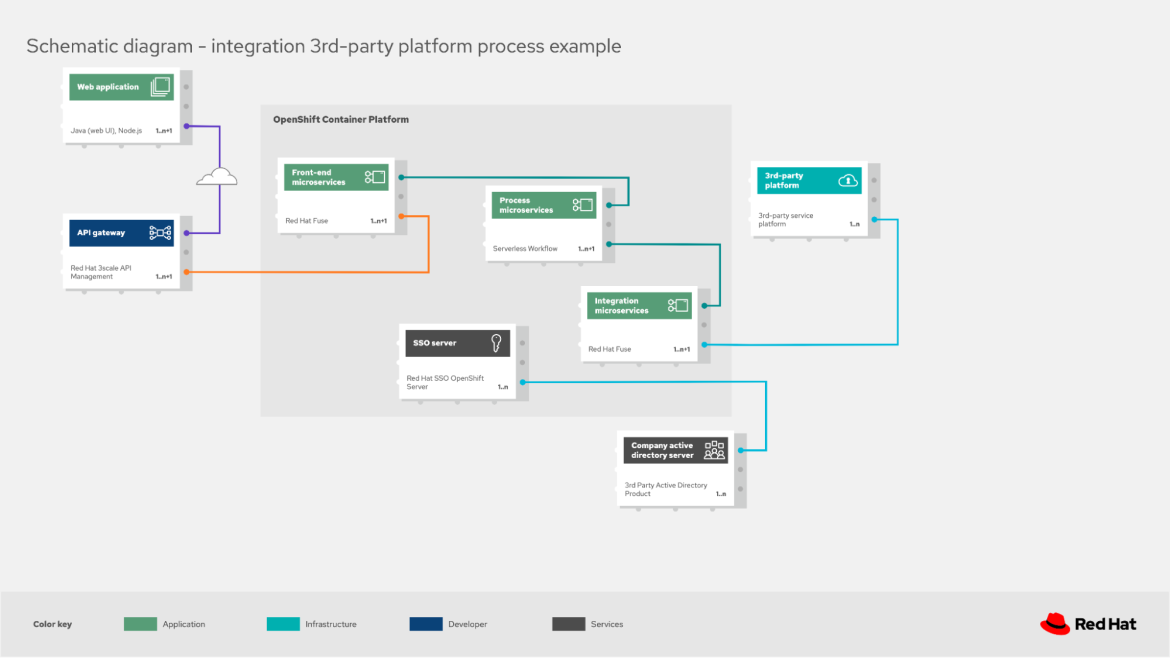This article will guide you through the essential steps of integrating third-party SaaS applications into your organization's infrastructure. We’ll take Customer Relationship Management (CRM) as our study point but the principles apply more broadly. By using tools such as Red Hat OpenShift and Red Hat Application Foundations, you can combine third-party SaaS applications that fit more broadly-applicable requirements with infrastructure and applications that cater to your specific business needs.
Why does it matter?
SaaS is heavily used for a variety of IT needs that are relatively similar across many different organizations. They can be quick to deploy while supporting customizations as needed. However, in complex environments, these SaaS applications can end up creating data silos because the information they store can be disconnected from other information the organization maintains elsewhere. This can make it challenging to integrate and share data effectively across the organization, especially when data is scattered across different locations including external public clouds.
To overcome this challenge, it's crucial to integrate these SaaS applications with your organization's computing infrastructure. Modern container platforms and API management play a significant role in achieving this integration.
For instance, container-based application development platforms like Red Hat OpenShift provide a flexible, portable, and scalable way to deploy applications. OpenShift offers a unified experience for both developers and operators, whether you're working in on-premise or cloud environments. This empowers developers to create more secure and scalable cloud-native applications—and even extend their reach to edge deployments.
When combined with Red Hat's API management capabilities within Red Hat Application Foundations, you get a powerful solution for facilitating more secure and efficient communication between different software applications. This includes the integration of various SaaS applications into your overall infrastructure. This integration bridges data silos so that you can connect and manage applications and data across different environments.

Let’s get implementing: A CRM Integration Journey with OpenShift
In the following sections, we delve into the implementation details of this solution. We will use the example of integrating a CRM SaaS application into a company's existing infrastructure using Red Hat OpenShift, focusing on API management and single sign-on (SSO) for improved security and ease of access.

Step 1: Infrastructure Setup with Red Hat OpenShift
The initial step is to establish a solid foundation for the microservices by setting up a Red Hat OpenShift cluster. Install the OpenShift cluster and configure it for container orchestration to support the microservices architecture required for the CRM integration.
Step 2: Microservices Development and Deployment
Once the infrastructure is ready, the development of microservices begins. Red Hat Application Foundations plays a key role here. It provides integration capabilities across different platforms and services, which is very important for a services-based architecture. Each microservice is containerized, and designed to perform a specific role within the CRM integration:
- Front-end microservices: A microservice is developed to serve as the entry point for external interaction with CRM SaaS applications, handling incoming requests and managing authentication and authorization. This service uses a component within Red Hat Application Foundations to provide more secure and efficient communication with the back-end internal system.
- Process microservices: A microservice is created to execute specific business processes, triggered by incoming requests and coordinated by the front-end microservices.
- Integration microservices: Another microservice is specifically designed for handling data transformations and communications between the CRM SaaS application and other systems. Using Camel K, which is integrated within Red Hat Application Foundations, this microservice efficiently connects disparate systems and handles data transformation.
Step 3: API Gateway Configuration
Here, you'd configure the Red Hat 3scale API Management (a component of Red Hat Application Foundations) to handle incoming requests. This involves defining the API endpoints, setting up rate limits, and configuring access policies. The gateway is programmed to authenticate against the SSO server using protocols such as OpenID Connect or OAuth 2.0. The API gateway is also responsible for routing requests to the appropriate microservices on the OpenShift platform.
Step 4: Authentication and Authorization
Authentication and authorization form the core of the system's security, so that only authorized users can access the services. Red Hat SSO integrates with a company's active directory server for authentication, providing a login experience for users that more securely manages user identities and permissions across the system.
Step 5: External CRM Integration
With the internal systems set up, the next critical step is the integration with the external CRM. The integration microservices would use the APIs provided by the CRM to perform actions such as retrieving customer data, updating records and handling CRM events. The integration would require handling authentication with the CRM service, likely using API keys or OAuth tokens, and so that data is sent in the correct format expected by the CRM.
Conclusion
In this integration implementation, we've laid a solid foundation with Red Hat OpenShift, developed a suite of microservices and APIs with Red Hat Application Foundations and strengthened user access with Red Hat SSO. We've crafted a unified and scalable environment that breaks down the data silos which often hinder organizational agility.
This implementation can be extended in a variety of ways. Red Hat AMQ (another component of Red Hat Application Foundations) can add efficient real-time messaging, taking your integration strategy to the next level. This addition facilitates real-time data flow across applications, so that your organization's data is integrated and accessible when and where it's needed. You can see an example of this in our Event Driven Automation architecture, enabling you to respond faster and more effectively to events, whether they are configuration changes, security incidents or emergencies. Coupled with monitoring tools, your infrastructure is set up to be more interconnected, responsive, and resilient, ready to support hybrid cloud strategy and drive operational excellence.
If you wish to dive deeper into the specifics of the architecture discussed in this article, explore the Integrating with SaaS Applications architecture.
For comprehensive insights into how Red Hat's solutions work together and with partner products, visit the Red Hat Architecture Center for detailed architectural information.
About the author
Ruby started as a Product Marketing Manager on the Red Hat Architecture team in 2022. She focuses on creating solution-driven content and bridging customer challenges with Red Hat's innovative open source solutions.
Browse by channel
Automation
The latest on IT automation that spans tech, teams, and environments
Artificial intelligence
Explore the platforms and partners building a faster path for AI
Open hybrid cloud
Explore how we build a more flexible future with hybrid cloud
Security
Explore how we reduce risks across environments and technologies
Edge computing
Updates on the solutions that simplify infrastructure at the edge
Infrastructure
Stay up to date on the world’s leading enterprise Linux platform
Applications
The latest on our solutions to the toughest application challenges
Original shows
Entertaining stories from the makers and leaders in enterprise tech
Products
- Red Hat Enterprise Linux
- Red Hat OpenShift
- Red Hat Ansible Automation Platform
- Cloud services
- See all products
Tools
- Training and certification
- My account
- Developer resources
- Customer support
- Red Hat value calculator
- Red Hat Ecosystem Catalog
- Find a partner
Try, buy, & sell
Communicate
About Red Hat
We’re the world’s leading provider of enterprise open source solutions—including Linux, cloud, container, and Kubernetes. We deliver hardened solutions that make it easier for enterprises to work across platforms and environments, from the core datacenter to the network edge.
Select a language
Red Hat legal and privacy links
- About Red Hat
- Jobs
- Events
- Locations
- Contact Red Hat
- Red Hat Blog
- Diversity, equity, and inclusion
- Cool Stuff Store
- Red Hat Summit

